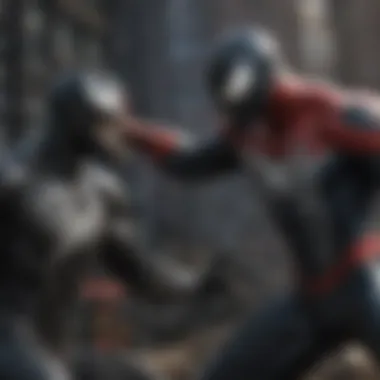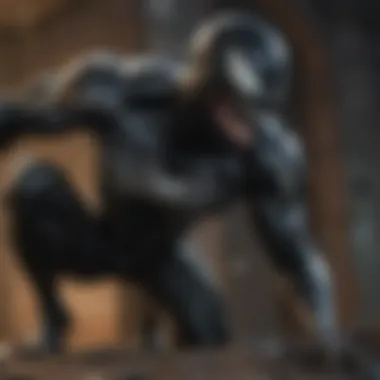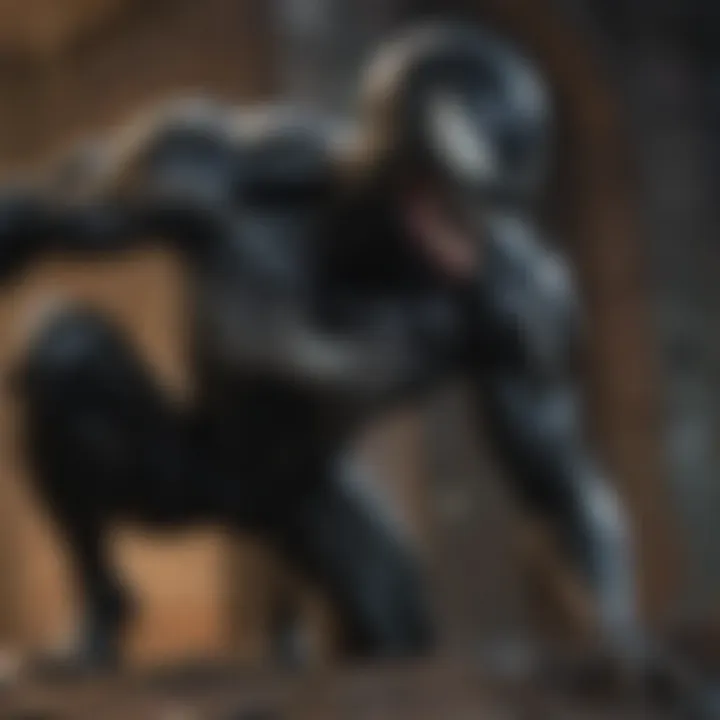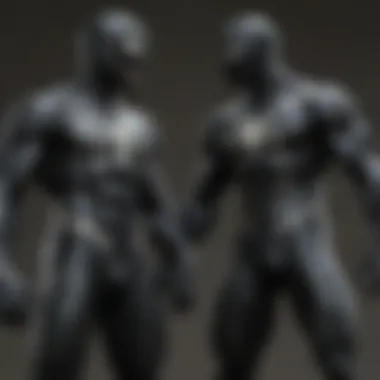An In-Depth Exploration of Venom in the Spider-Man Universe
Intro
In the realm of comic book narratives, few characters garner as much interest as Venom within the Spider-Man universe. His complex background, emotional depth, and contradictory nature place him firmly in the anti-hero category. Venom's inception stems from the imaginative minds that shaped Spider-Man’s universe, allowing barriers between hero and villain to blur. This article aims to provide a detailed exploration of Venom, illuminating his multifaceted character from his psychological complexity to his evolving relationship with Spider-Man.
Spider-Man Character Analysis
Background
Spider-Man first appeared in Amazing Fantasy #15 in 1962, created by Stan Lee and Steve Ditko. Peter Parker, a high school student, gains superhuman abilities after being bitten by a radioactive spider. The character quickly became a symbol for responsibility and resilience, often struggling with duality of his life as a student and a superhero. He fights to protect the innocent while contending with personal loss and sacrifice. Over the decades, Spider-Man's origin and development delineate a narrative filled with growth and introspection.
Powers and Abilities
Spider-Man's powers are distinctive and wide-ranging. He possesses:
- Superhuman Strength: Spider-Man can lift heavy objects and overpower opponents.
- Agility and Reflexes: His quick reflexes allow him to respond rapidly to danger.
- Wall-Crawling: This ability enables him to traverse vertical surfaces easily.
- Spider-Sense: A sixth sense that alerts him to danger, enhancing his survival.
- Web-Shooting: Using his web-shooters, he can swing through the city and ensnare enemies.
These abilities make him an iconic superhero, yet they do not come without cost, as he balances his powers with the consequences of his vigilance.
Character Development
As his story unfolded, Spider-Man faced various challenges that shaped him profoundly. Key moments in his journey include:
- The Death of Uncle Ben: A pivotal tragedy teaching him the importance of responsibility.
- The Clone Saga: An intricate storyline exploring identity and legacy.
- The Struggle Against Venom: Their battles highlight the psychological conflict within Peter Parker.
Each facet of his journey contributes to his evolution from a naive teenager into a mature hero grappling with moral dilemmas.
Latest Spider-Man News Update
Comic Books
Recent comic book releases have rekindled interest in Spider-Man, showcasing new adventures and encounters. Fans can explore stories like The Amazing Spider-Man series where Peter encounters both old foes and new characters.
Movies
Upcoming Spider-Man films generate excitement. The latest news includes casting rumors and trailers that hint at how Spider-Man's universe will expand in the cinematic landscape. Fans eagerly anticipate how Venom may feature in future storylines, especially following the events in the Venom films.
Video Games
The gaming landscape also embraces Spider-Man. New releases for platforms like PlayStation continue to enhance gameplay. Players will find updated missions, new villains, and intricate stories that further explore the Spider-Man universe.
Top Villains in Spider-Man Universe
Main Antagonists
Spider-Man’s rogues' gallery is vast and varied. Notable villains include:
- Green Goblin: One of Spider-Man’s most menacing foes, with personal ties to Peter.
- Doctor Octopus: A formidable adversary known for his intellect and mechanical tentacles.
- Venom: A unique villain due to his complex relationship with Spider-Man.
Origins and Motivations
Understanding the backstories of these villains is crucial. Each character presents a unique motivation and narrative that enriches Spider-Man’s experiences. For instance, Venom's origin as an alien symbiote and its connection to Peter highlights themes of obsession and revenge.
Memorable Battles
Certain confrontations stand out in the narrative. High-stakes battles between Spider-Man and Venom showcase emotional intensity, often testing both characters’ limits. The fight sequences depict their psychological struggle as much as their physical confrontations.
Spider-Man Movie Reviews
Plot Summary
Recent Spider-Man films reveal intricate narratives that explore Peter Parker’s growth and challenges. Each installment presents its own twist on classic storylines, maintaining an engaging rhythm.
Character Portrayals
Actors portraying Spider-Man, like Tom Holland, bring depth to the character while embodying the spirit of youth and heroism. Supporting characters also lend credibility and layers to the overall narrative.
Visual Effects
Visual effects play a crucial role in bringing the Spider-Man universe to life. The action sequences, propelled by advanced CGI, enhance storytelling and immerse viewers in a dynamic superhero experience.
"The complexity of Venom as a character reflects broader themes of identity and morality within the Spider-Man saga."


By analyzing these elements, we uncover the intricate web that is the Spider-Man universe, highlighting Venom's significance and influence throughout its history.
The Origin of Venom
Understanding the origin of Venom is essential for grasping his significance in the Spider-Man universe. Venom’s creation marks a pivotal moment in comic book history, encapsulating themes of identity, power, and duality. This foundation sets the stage for Venom's complex interactions with Spider-Man and other characters. It provides insight into the psychological depth that defines Venom, as well as the broader implications of his character in both comics and films. Without this origin story, the later developments in Venom's character arc would lose their relevance and impact.
Creation in the Comics
Venom was created in the early 1980s during the Marvel comic era when storytelling began to explore darker themes and complex characters. The character first appeared in "The Amazing Spider-Man" #300, published in 1988. The initial concept arose from writer David Michelinie and artist Todd McFarlane, who intended to create a villain that could embody the darker aspects of Spider-Man’s own powers.
The symbiote itself was originally introduced in "The Amazing Spider-Man" #252, appearing as a black suit that Spider-Man utilized to enhance his abilities. However, Spider-Man soon discovered that the suit had a negative impact on his personality. This led to him rejecting the suit, which subsequently bonded with Eddie Brock, a disgraced journalist who shared a mutual hatred for Spider-Man. This bond did not just give birth to the character Venom; it also introduced the idea of an antagonist who was as complex as Spider-Man himself.
The Symbiote's Arrival
The arrival of the symbiote into the Spider-Man narrative serves as a device to explore deeper themes about fear, power, and responsibility. When Spider-Man acquires the black suit, it allows him to perform at higher levels than ever before. But this new attire proves to be more of a curse than a blessing. The symbiote fuels Spider-Man’s darker tendencies, pushing him toward arrogance and aggression.
Once rejected by Spider-Man, the symbiote finds a new host in Eddie Brock. This transformation is significant; Brock, a once-ambitious reporter, becomes Venom, driven by revenge against the hero who wronged him. This shift from a seemingly ordinary character into a powerful anti-hero illustrates the fragility of identity and how external factors can dramatically change a person's path.
"Venom’s origin reflects the duality of human nature—the struggle between light and dark, heroism and villainy."
The symbiote's arrival fundamentally alters the landscape of the Spider-Man universe, paving the way for a dynamic that explores not just external conflict but also internal struggles within both characters. Through this bond, the juxtaposition of Venom against Spider-Man becomes a crucial narrative element, establishing a rivalry that is both compelling and layered.
Venom’s Relationship with Spider-Man
Venom's relationship with Spider-Man is one of the most complex and layered dynamics within the comic universe. The symbiotic connection this character has with Spider-Man not only defines Venom's persona but also shapes the narrative arcs around both characters. Their relationship raises questions about identity, morality, and the nature of good and evil. Each encounter has been pivotal for highlighting the themes of loss, reciprocity, and the dark seduction of power.
In the beginning, Venom was created as a direct response to Spider-Man's actions. The bond with the symbiote catalyzed a transformation within Eddie Brock, turning him into Venom, which challenged Spider-Man's character. The duality found in this relationship provides a rich backdrop for storytelling. Readers are drawn into an emotional landscape where loyalty and betrayal intermingle, making it more than just a battle between hero and villain.
The Symbiotic Bond
The relationship between Spider-Man and Venom is often characterized by a powerful symbiotic bond. This connection is not merely physical; it is deeply psychological. When Eddie Brock becomes Venom, he forms a union with the symbiote originally bonded with Spider-Man. This connection amplifies his strengths and allows him to mirror many of Spider-Man's abilities. However, with these powers come darker instincts.
- The symbiotic bond creates a unique dynamic where both characters influence each other.
- Venom, who possesses a venomous hatred for Spider-Man, cannot escape the psychological footprint left by his host. This bond is both a source of strength and a psychological burden.
- The conflict manifests as Brock struggles with his own identity, influenced heavily by the symbiote's urges.
Consequently, every clash between Spider-Man and Venom is not just a physical confrontation. It brings to the surface deeper themes concerning identity and the moral choices made by both characters. The symbiotic bond thus symbolizes intertwined destinies, compelling readers to consider the broader implications of such relationships.
Conflict and Rivalry
The rivalry between Venom and Spider-Man is one marked by intense personal conflict. While many adversaries seek power or destruction, Venom's vendetta is deeply personal. Eddie Brock's hatred for Spider-Man originates from his preconceived beliefs about the importance of accountability. He sees Spider-Man as a symbol of injustice, fueling his obsession with destroying him.
- Their conflicts are not simply battles; they also delve into themes of responsibility and vengeance.
- Venom often exploits Spider-Man's weaknesses, attempting to expose the hero's flaws.
- This rivalry evolves, reflecting their respective journeys. While Spider-Man struggles with the burden of his responsibilities, Venom embodies a rejection of those same principles.
"The rivalry between Venom and Spider-Man offers a canvas for exploring deeper moral questions; it's a dance of shadow and light."
The psychological warfare engaged in their confrontations reveals vulnerabilities, compelling both characters to confront their beliefs. As much as Venom wants to defeat Spider-Man, there lies a longing for recognition, an acknowledgment of shared pain. This dynamic ensures that their relationship is portrayed with nuance and complexity, appealing to readers who appreciate depth in character development.
Character Development Over the Years
Character development is crucial to understanding Venom within the Spider-Man universe. It showcases how a character can evolve from a straightforward villain to a complex anti-hero. The narrative of Venom highlights significant themes such as morality, identity, and redemption. Each stage of Venom's journey reflects societal changes and influences in comic book storytelling. This evolution provides readers with a lens to explore the nature of good and evil, making Venom's character arc worth examining closely.
Initial Villainy
Venom first appeared as a villain, primarily in the Spider-Man comics. His creation was a result of Spider-Man's own choices. The black suit, initially a costume upgrade for Spider-Man, introduced the symbiote. This suit was later revealed to be a living organism that feeds on Spider-Man's aggression. Venom, the resultant character, became a formidable adversary. The symbiote bonds with Eddie Brock, a journalist who feels wronged by Spider-Man. This bond amplifies Brock's resentment, transforming him into Venom.
In the comics, Venom manifests a rage fueled by his connection to Spider-Man. He possesses many of Spider-Man's abilities, making him a threatening foe. His knowledge of Spider-Man's weaknesses gives him an edge. Venom's early portrayals focus on his obsession with destruction and personal vendetta against Spider-Man. Notably, he symbolizes the consequences of Spider-Man's actions, challenging the moral underpinnings of heroic choices. This exploration of villainy establishes Venom's character as not just a villain, but an essential component of Spider-Man's world.
Transformation into an Anti-Hero
As time progressed, the depiction of Venom began to shift. The narrative moved toward a more nuanced portrayal, reflecting changing audience expectations. Venom's transformation into an anti-hero redefined his role. This transition has roots in his complex motivations and desire for redemption. Rather than merely seeking vengeance, Venom begins to protect those he sees as innocent. This evolution aligns him closer to Spider-Man, yet he retains his darker elements.
In various comic storylines like "Lethal Protector," Venom adopts a protagonist role. He fights against villains and protects others from harm. This willingness to act for the good, albeit with violent methods, adds layers to his character. Fans began to connect with Venom on a deeper level.
"Venom became a symbol of the struggle between personal identity and societal expectations. Many fans identified with his fight for acceptance and redemption."
These developments ensure that Venom's character remains dynamic. His journey encapsulates themes of duality and the search for purpose.
The Venom Lore in Comic Books
The lore of Venom within comic books is a crucial aspect that shapes the character's identity and significance in the Spider-Man universe. Understanding this lore helps fans appreciate the depth and evolution of Venom as a character. Venom is more than just a mere villain; he embodies a complex narrative filled with moral ambiguity and conflicting motives. This section delves into essential storylines that define Venom’s existence and explores his relationships within the Spider-Man narrative.
Key Comic Storylines
Several key storylines have been pivotal in defining Venom's character. One of the most significant arcs is the "Venom: Lethal Protector" series, published in the early 1990s. In this storyline, Venom transitions from a villain to an anti-hero. He protects a group of innocents in San Francisco, showcasing his duality. This marked a turning point in how audiences viewed him, emphasizing his capability for good, despite his brutal methods.


Another important storyline is the "Planet of the Symbiotes", which explores the origins of symbiotes and their connection to Venom. This arc expanded the lore around symbiotes, introducing new characters and deepening the understanding of their addictive nature and the implications of their bond with hosts.
The "Maximum Carnage" saga is also noteworthy. In this crossover event, Venom, despite his own dark tendencies, teams up with Spider-Man and other heroes. Their reluctant alliance against Carnage not only highlights the complexity of heroism but also portrays how Venom's motivations align differently depending on the context.
Allies and Enemies
In terms of allies, Venom often finds himself in complicated relationships. Spider-Man, despite their contentious history, becomes both an ally and enemy multiple times. Their connection is complicated by the fact that both characters share a deep understanding of responsibility, even if they view it through different lenses.
Other notable allies include characters like the Punisher. Their shared anti-heroic traits form a unique bond that allows them to collaborate against common threats. This distinctive camaraderie often showcases Venom's blurred lines between good and evil.
Conversely, Venom's enemies extend across various characters, primarily those who represent factors he hates or challenges he embodies. Carnage, who emerges as a chaotic and unrestrained counterpart to Venom, becomes one of his most prominent foes. Their confrontations emphasize the internal struggle within Venom, as he battles against a variant of himself, pushing the boundaries of his darker instincts.
Ultimately, the lore surrounding Venom in comic books is rich and layered, revealing the complexity of his character through different narratives. It provides context that enhances our understanding of his motivations and morality within the larger Spider-Man saga.
Venom stands as a testament to the possibilities of redemption, even amidst violence and chaos.
This intricate web of alliances and rivalries makes Venom a central figure in the Spider-Man universe, enriching both his own story and that of Spider-Man.
Venom in Film Adaptations
The portrayal of Venom in film adaptations marks a significant area of interest within the Spider-Man universe. Movies contribute to the character's mythos in ways that comics sometimes cannot. They reach wider audiences, potentially reshaping how both fans and newcomers perceive Venom. This section investigates early cinematic appearances, the groundbreaking standalone movie, and future directions for Venom in cinema.
Initial Forewords
Venom first appeared in Spider-Man 3, released in 2007. This film introduced Eddie Brock, a photographer who shared a deep-seated animosity toward Spider-Man. The depiction of Venom in this context was met with mixed responses. Some fans expressed excitement at seeing the character on screen, while others criticized how the film handled the character's complexity. Instead of a layered anti-hero, Venom was shown largely as a villain. Despite this, the film inspired interest in further explorations of Venom's narrative.
In addition to Spider-Man 3, Venom has been featured in animated adaptations. The 1994 Spider-Man animated series and later adaptations showcased his character, emphasizing the duality of good and evil through his interactions with Spider-Man. These various introductions helped shape a more nuanced understanding of Venom within the broader Spider-Man lore.
The Standalone Movie
The 2018 film Venom marked a turning point in the cinematic depiction of the character. It allowed for a more in-depth exploration of Eddie Brock's persona as an anti-hero rather than just a villain. This film focused on the symbiotic relationship between Eddie and the alien symbiote, revealing the complexities within their dynamic. The narrative provided insights into Eddie's struggles, his motivations, and ultimate transformation. As viewers, we see Eddie Brock want redemption and to use Venom's abilities to do good in a world that wronged him.
The film was generally well-received and resulted in considerable box office success. Its positive reception led to discussions about whether a sequel would follow and how it might expand on the mythos established.
Future Prospects in Cinema
Looking forward, the future of Venom in cinema appears promising. Already, a sequel titled Venom: Let There Be Carnage has been released, introducing Carnage, another formidable character from the comics. This film further explores the chaotic nature of the symbiotes and the moral ambiguity surrounding them.
Additionally, there are rumors of potential crossovers with other characters within the Spider-Man franchise. Projects like Spider-Man: No Way Home hinted at a vast multiverse where Venom could interact with various iterations of Spider-Man. This opens avenues for rich storytelling and character development, enhancing Venom's significance within the cinematic universe.
"Venom's cinematic journey shows the flexibility of his character. From villain to anti-hero, he embodies a modern narrative that resonates with many viewers."
In summary, Venom's depictions in films have evolved significantly. Initial introductions laid a foundation, while the standalone movie redefined the character's image. The future seems bright for Venom, as new films and potential crossovers could offer even deeper explorations of his complex nature.
Venom's Psychological Profile
Understanding Venom's psychological profile is crucial for grasping his complexity as a character in the Spider-Man universe. Venom embodies both the dark and light aspects of humanity. This duality often drives the narrative forward, revealing deep insights into his character and the broader themes of morality, identity, and trauma.
The Dichotomy of Good and Evil
Venom exemplifies the struggle between good and evil within the human psyche. On one hand, he is portrayed as a villain, often opposing Spider-Man. On the other hand, he evolves into an anti-hero who defends the innocent. This shift is not simple. It reflects his internal battle against malevolent impulses instigated by the symbiote.
The symbiotic relationship makes him more powerful, but also manipulative. Eddie Brock, the human host, fights to control the urges and instincts imparted by the symbiote. This ongoing conflict reveals a broader commentary on the human condition. The line between hero and villain blurs, pushing readers to question the nature of morality itself.
"We all have shadows lurking within us, but it is our choices that define who we are."
Trauma and Identity
Eddie Brock's history is marked by trauma, influencing his behavior and decisions. He suffers from deep-seated issues that shape his identity. When the symbiote bonds with him, it amplifies his negative emotions, like anger and resentment. As a result, his psyche becomes a battleground. The connection is not merely physical; it shapes his very essence.
This trauma leads to complex dilemmas. Is he the same person he was before the bond, or has he transformed entirely? These questions resonate within the narratives, making Venom relatable. Readers see his vulnerabilities, his attempts to reconcile his former self with the new entity he becomes. The struggle for identity captures the essence of behavioral psychology, presenting a multifaceted character deserving of analysis.
In summary, Venom's psychological profile adds depth to his character within the Spider-Man universe. By understanding the interplay of good and evil, along with the impact of trauma, readers become more engaged with his narrative. This psychological complexity is the cornerstone of Venom's lasting significance.
Cultural Impact and Reception
The cultural impact of Venom in the Spider-Man universe is significant, reflecting his complexity and adaptability. This character has transcended his role as a mere antagonist, becoming a defining figure in the Spider-Man narrative and broader popular culture. His evolution has been marked by various interpretations, each of which has contributed to his lasting appeal.
Fan Response Over Time
Fan response to Venom has been dynamic, changing with different comic runs, media adaptations, and societal trends. Initially portrayed as a monstrous reflection of Spider-Man, Venom's character tapped into themes of rage, vengeance, and the duality of human nature. Many readers resonated with this portrayal, as it echoed their own struggles with inner demons. Over the years, Venom evolved beyond villainy into an anti-hero, a shift that garnered a new wave of appreciation from fans.
"Venom stands out not just for his powers, but for the shadows he embodies and the choices he makes."


This complexity allowed him to maintain a strong fanbase. Notably, the reception varies depending on the medium. Comic book readers often expect depth and nuance, while moviegoers might focus more on action and spectacle. This divergence leads to contrasting opinions on his portrayal in different formats.
Merchandising and Beyond
Venom's commercial success is evident in various forms of merchandising, capturing the character's essence in a profitable way. From action figures to apparel, the character has become an icon recognized well beyond comic book shops. The popularity of the standalone film in 2018 further amplified this aspect, allowing new audiences to engage with him.
Today, Venom is not just confined to comics. He extends into toys, video games, and collectibles that celebrate his legacy. The merchandise often highlights key visual features such as the character's distinct symbiotic form and striking logo.
In summary, Venom’s cultural footprint is vast. His ability to resonate with different audiences through various media showcases his significance and enduring appeal. Whether through fan discussions or product sales, Venom remains a crucial part of Spider-Man's universe.
Incorporating Venom into the Spider-Man Universe
The integration of Venom into the sprawling Spider-Man universe represents a significant narrative exploration. This character adds depth and complexity, enriching the already intricate relationships that exist within the Spider-Man lore. Understanding Venom's role is pivotal in appreciating the overarching themes of duality, morality, and identity that are prevalent in not just Spider-Man's story, but in the entire Marvel universe.
Venom serves as a catalyst for various plot lines. His arrival on the scene prompts changes that not only affect Spider-Man but also other characters surrounding him. Venom's unique abilities as a symbiote challenge Spider-Man's heroism, forcing him to confront darker aspects of his own character. This tension between hero and anti-hero allows writers and creators to explore deeper moral dilemmas.
Interconnected Story Arcs
The symbiotic relationship between Venom and Spider-Man forms a critical part of the intertwining story arcs in the comics. The shared history is filled with conflicts that lead to significant plot developments. Writers utilize these connections to build larger narratives that enhance reader engagement.
- Origin Story: Venom's background ties directly into Spider-Man’s. The connection begins with Eddie Brock, who shares a mutual hatred for Spider-Man. This hatred anchors Venom's motivations.
- Sagas and Events: Major storylines, such as the "Maximum Carnage" saga, demonstrate how Venom impacts other characters like Carnage and even Spider-Man’s allies. The conflicts created in these arcs stress the importance of Venom within the realm of comic book storytelling.
The interrelatedness of other characters' arcs brings additional layers. As Venom’s actions impact those around him, they create consequences for Spider-Man and his allies. This interconnectedness highlights the ripple effects that one character can have on the larger narrative landscape.
Venom as a Foil to Spider-Man
In literature and storytelling, a foil is a character that contrasts with another to highlight particular qualities. Venom acts as a foil to Spider-Man in many ways. While Spider-Man embodies heroism and responsibility, Venom thrives on chaos and vengeance. This contrast sharpens the definition of both characters and enhances the narrative.
- Moral Complexity: Venom's motivations often stem from personal trauma and a desire for vengeance, which can mirror or contrast Spider-Man’s struggles. This complexity allows Sonic Venom to be both a friend and foe, complicating Spider-Man's quest for justice.
- Similar Powers, Different Ethos: Both characters possess spider-like abilities, but they wield them with differing philosophies. Spider-Man uses his powers for altruistic purposes, while Venom often seeks to exploit them for his gain. This divergence emphasizes the ongoing battle between good and evil, a common theme in comic books.
Venom’s existence raises critical questions about the nature of heroism versus villainy in the Spider-Man narrative.
In summary, the incorporation of Venom not only serves to enrich the Spider-Man universe but also provides fertile ground for thematic exploration. By examining interconnected story arcs and the duality between Venom and Spider-Man, the true depth of these characters is revealed. This analysis contributes significantly to understanding the ongoing evolution and relevance of both figures in contemporary media.
The Future of Venom in Media
The future of Venom in media represents a critical junction not only for the character but for the broader Spider-Man narrative. Venom has established himself as more than just a supervillain; he is an embodiment of duality and depth. This section will explore the anticipated trajectories for Venom in comic books and films, emphasizing how these developments will influence the character's legacy.
Anticipated Storylines in Comics
Venom's journey in the comic universe is far from stagnant. Several storylines loom on the horizon that could significantly shape his character. Marvel comics continually re-invent heroes and villains to keep the audience engaged, and Venom is no exception.
Potential plot arcs could delve deeper into the symbiote's origin, perhaps focusing on the complexities surrounding its lineage. Recent trends in comic writing suggest an exploration of Venom’s relationship with other symbiotes, examining how these connections could shift existing dynamics.
Additionally, writers may explore Venom's engagement with newer heroes and villains. There is a chance to introduce crossovers that could lead to unexpected alliances or conflicts. This direction can enrich the storytelling universe and enhance the significance of Venom’s role in Spider-Man's world. Fans are eager for darker, more intricate plots rather than the traditional hero-villain dichotomy.
Potential Cinematic Developments
The terrain of Venom in cinema is equally exciting. Following the release of standalone films, there is a clear demand for more content centered around this character.
Future films may incorporate Venom in larger narratives alongside Spider-Man, aligning with the expanding Spider-Verse. The recent trend of multiverse adaptations in films can be a fitting backdrop for Venom’s character development. Venom's clash with Spider-Man is foundational and can be revisited with new creative approaches. Such interactions could prove crucial in bridging character arcs and fulfilling narrative promises that have yet to be explored.
Moreover, Venom could see introductions to figures from the Marvel Universe, further expanding his exposure and influence. Collaborations with popular heroes or confrontations with formidable foes can revitalize the cinematic portrayal.
"The future of Venom is about exploring the shades of grey rather than the black-and-white morality typically represented in superhero sagas."
With cinematic technology evolving, visual representations can become more dynamic. This opens the door for greater depictions of the symbiote’s abilities and characteristics, allowing audiences to experience the character in more immersive ways. As cinematic capitalism thrives, the onus will be on storytellers to weave profound narratives that resonate with both new and established audiences.
As we contemplate the Future of Venom in Media, it is evident that the character holds significant promise for growth and intrigue. Every imagined storyline and development offers a chance to deepen interactions within the Spider-Man universe, allowing Venom to flourish as a symbol of complexity.
End
In the conclusion of this article, we reflect on the complex layers that make Venom a significant figure within the Spider-Man universe. Venom is not just a formidable opponent for Spider-Man, but also a character that raises thoughtful questions about identity, morality, and the nature of good and evil. This depth is why he endures in popularity among fans.
Summary of Venom’s Significance
Venom serves as a compelling symbol of the struggle between personal demons and external influences. He embodies the idea of the anti-hero, where his motivations often clash with conventional morals. This complexity allows readers and viewers to see facets of their own struggles within him. Moreover, Venom’s evolution from villain to anti-hero reflects a broader narrative arc that is prevalent in contemporary storytelling.
- Significant Aspects of Venom:
- The Duality of Character: His relationship with Spider-Man showcases the dual nature of his existence, combining vulnerability with monstrous power.
- Psychological Depth: The character’s struggles with identity resonate on a psychological level, offering insights into themes of trauma and acceptance.
- Cultural Impact: Venom has transcended comic books to become a pop culture icon, appearing in various media and merchandise. This reinforces his significance beyond the pages of comic books.
Final Thoughts on the Character
As we conclude, it is evident that Venom's impact on the Spider-Man universe is profound. He challenges the traditional boundaries between heroism and villainy. The character evolves alongside societal changes and reflects the complexities of human nature. Fans not only enjoy his aggressive confrontations with Spider-Man but also relate to the introspective journey he represents.
In summary, Venom’s narrative serves a dual purpose: it entertains while simultaneously offering a rich exploration of critical themes. The discussions surrounding Venom continue to be relevant, promoting dialogue about morality, identity, and the choices we make.
"Venom is not merely a villain; he is a representation of our own struggles with the darkness within. As such, he holds a mirror to the best and worst of humanity."







